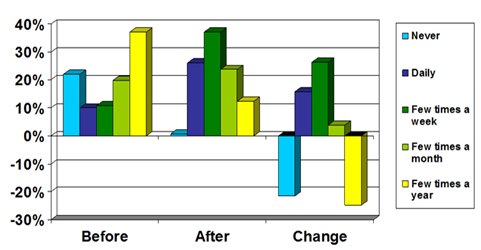
Resident transit use before and after possessing an Eco Pass. Source: City of Boulder (click to enlarge)
For many years, Boulder County and the City of Boulder have been offering financial incentives to businesses and neighborhoods to sign up for the RTD Eco Pass. Extensive before-and-after surveying indicates that this is one of the most cost-effective tools to increase transit use. In fact, City of Boulder data suggests an individual is 7 to 9 times more likely to take the bus with an Eco Pass than without one. The financial incentives efforts have paid off and today about half of City of Boulder residents have an Eco Pass.
While this model has been very successful, there are several disadvantages to signing up new businesses and neighborhoods with an incremental approach. First, the process is incredibly time consuming for local agency staff, RTD and the businesses and neighborhoods themselves. The administrative effort required to raise the needed funds and to complete RTD contracting is substantial. Since the businesses and neighborhoods most interested in joining the program have already done so, remaining entities take even more education and staff investment. Second, participation is primarily from businesses with higher income staff and neighborhoods with adequate time and financial resources. Many city and county residents who could most benefit from a pass have no means to obtain one.
To understand how to address these two issues it’s useful to outline the basic premise of the Eco Pass pricing model. Eco Pass works on what is often referred to in transportation planner circles as the insurance model. For a given neighborhood, all residents have access to a pass regardless of how much or how little each individual uses it. The total cost that RTD charges to provide passes to that group is based upon how much money the group paid RTD in the form of fares before the Eco Pass program started. This is determined by surveying the neighborhood and is generally considered a cumbersome and inaccurate process.
The New Mechanism
For the past three years, Boulder County has been rethinking the way we promote and execute Eco Pass subsidy programs. We have expanded the traditional definition of a neighborhood to be an entire municipal boundary or, in some cases, an even larger political boundary such as a library district. In this model, anyone living inside that boundary receives an Eco Pass. Rather than survey every person living inside that community, we set the price based on how much money RTD receives on the routes that serve that community, something that RTD tracks closely. For example, in Lyons, the Y route generates about $50,000 in revenue a year. Since this is the only route serving Lyons, the annual Eco Pass contract for the Town of Lyons is $50,000.
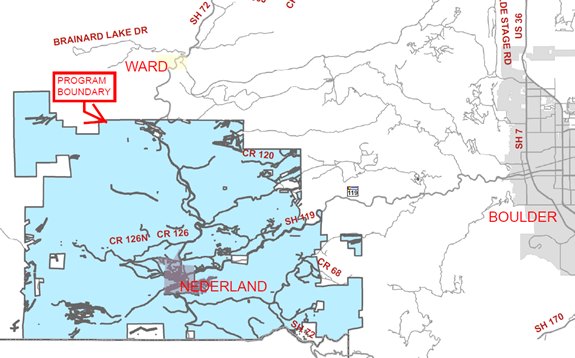
Geographically, the Nederland Eco Pass district is larger than all other neighborhood programs combined.
Transit Use: A Public Good
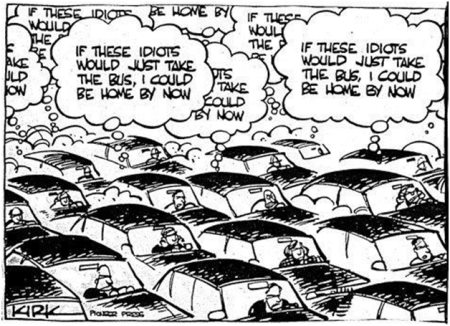
Many people who never use transit may vote to increase taxes for a program that encourages others to take the bus.
Many residents object to paying any additional tax for a transit pass that they believe they will seldom or never use. While this objection is understandable, we in fact pay for many services that we never directly use. For example, many people without school-age children will vote to increase taxes for additional school programs. For a community-wide Eco Pass to become a reality, it will be critical for City of Boulder and Boulder County residents to recognize that transit use is a public good. Individuals who never take a bus still benefit from others taking the bus in the form of reduced congestion, improved air quality, enhanced safety on our roads, and increased mobility for our workforce and children.
A good analogy for a community-wide transit pass is the library system. Our community believes that having access to library resources is a public good and something we want to encourage. As such, we make visiting the library and checking out books free to the user. More specifically, we detach the cost of providing the public service from the use of that service. Instead of charging for use of the library, we implement city-wide property or sales taxes that everyone pays.
In fact, our local roads are paid for in exactly this way—general property taxes instead of user fees. Transportation economists have long argued that this induces people to drive: individuals choose to use a good for which they have already paid. If access to transit is seen as the same public good as access to libraries or use of streets, then it should have a similar funding mechanisms.
Transit Revenue
To understand the price of a community-wide pass it’s helpful to review current RTD revenue streams. About 75% of RTD’s revenue comes from taxes and the majority of that comes from a district-wide 0.6% sales tax. A small amount of gas tax makes its way back to RTD through the Federal Transit Administration for capital purchase (stations, light rail vehicles, etc.) to make up the rest of the 75%. About 25% of RTD’s revenue comes from user fees, also known as farebox revenue. Farebox revenue is the money RTD collects in cash fares, 10-book ride tickets, monthly passes and annual Eco Pass contracts.

The program cost for a community-wide Eco Pass is the replacement farebox revenue plus the cost to provide additional transit service resulting from increased demand.
It’s worth underscoring that individuals who never use transit are still paying for about 75% of the services through general taxes. In this sense, our tax structures are already set up to recognize transit as a public good. Development of a community-wide pass would take it the rest of the way to being 100% tax funded, user-free. In other words, a new funding source to cover the 25% farebox revenue and make transit use “free” to everyone leverages the existing 75% that we already pay.
Replacement Revenue
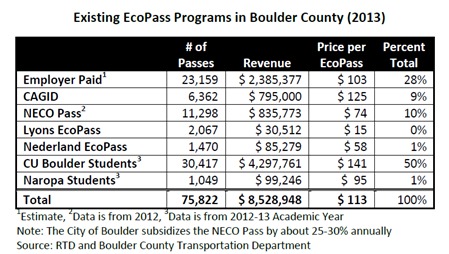
Current Eco Pass contracts within Boulder County make up about half of the total revenue RTD receives in fares.
The good news is that as a community we already pay for most of the cost of a community-wide pass. In fact, existing farebox revenue comprises around 85% of the cost of the program. As such, 85% of the funding for the program is really replacement of already paid funds and only 15% requires new funding. Instead of giving the money to RTD in the form of cash, monthly passes and Eco Pass contracts, this program would use tax-generated revenues to provide RTD a lump sum annual dollar amount in exchange for Eco Passes for all residents and employees.
This low percentage of required new funding is very different than other types of programs that typically need to be funded at 100%. Further, it is incorrect to consider “what else could be done” with 85% of the total cost of a community-wide pass since these funds are already committed to transit fares. The only new funds that would need to be collected would be to cover additional transit service, discussed in the next section.
Additional Transit Service
Projections of increased ridership vary between 22% and 62% based on underlying assumptions and geographic extent of the program. Largely this increase in ridership will fill empty seats making the transit system more productive and more efficient. On some runs on some routes, however, there isn’t enough capacity to absorb the increase in passengers. For example, the 7:35 a.m. Boulder-bound DASH is already close to standing room only. Increasing ridership will trigger the need for RTD to add more service on that run at that time. Since the need to provide this additional service is triggered by the new program, RTD will request that the local agencies come up with the funds to provide the additional service. Boulder County and City of Boulder staffs understand the budgetary constraints that RTD has and support this direction.
Geographic Equity
There are very different levels of transit service within the City of Boulder and even greater differences within Boulder County. Even if individuals recognize a community pass as a public good they will be more likely to support a new tax if it is roughly proportional to the level of transit service to which they have access. For example, if a property tax were the funding mechanism, it would seem fair to charge properties near downtown more than properties east of Folsom.
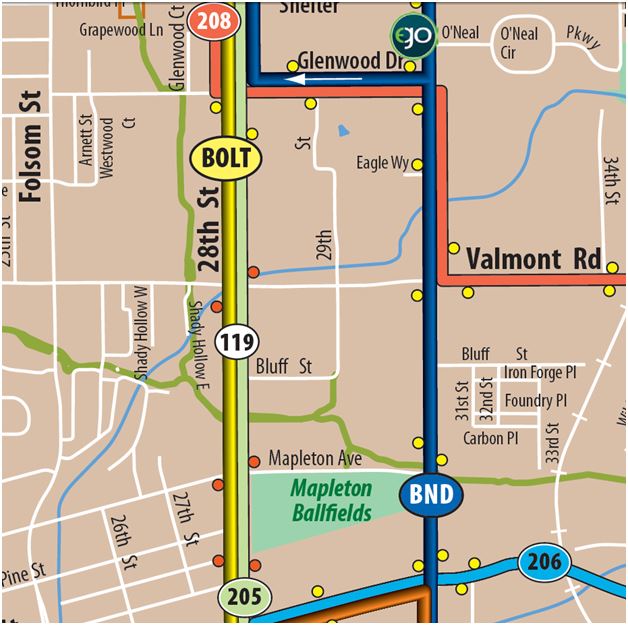
Businesses in downtown Boulder have more transit options than those in east Boulder, a segment of which is shown here.
RTD’s current business Eco Pass pricing model actually recognizes differences in transit service levels and has two pricing zones inside the City of Boulder. A business located inside the high service level area pays a little over twice the amount per person that a business outside that level pays. Many businesses considering the Eco Pass program are frustrated with this pricing structure, especially when the zone boundaries are somewhat arbitrary and not based upon actual walk distances to transit stops.
One possibility for the business Eco Pass program—which could find traction with RTD—is to increase the number of zones within the city so that price variation between zones is less dramatic. In addition, one exciting development is that the RTD Smart Card Program, started January 2013, tracks actual transit usage of employees within each pricing zone. The annual price is based upon the previous year’s usage, thus reflecting levels of service available to each zone. The maps below show two pricing zone possibilities. Note that CAGID and CU already act as individual pricing zones covering a large number of individual employment locations.
Next Steps
The recently completed Community-wide Eco Pass Feasibility Study provides a good understanding of the current amount of money that city and county residents and employees pay RTD every year in the form of fares. The next step is to further explore various funding streams to replace this revenue. Possible mechanisms that warrant exploration include residential property tax, commercial property tax, sales tax and employee head tax. Each has numerous pros and cons that must be fully explored and vetted with the community. In addition to the funding streams, administrative procedures need to be developed and coordinated among dozens of agencies. How do we issue passes to over 100,000 people and what is the best agency to lead the effort?
Despite the substantial work left to be done, we believe that we can build upon the success of recent community-wide pass efforts in the county and develop a new model for transit pass programs. If you support this effort we encourage you to contact your elected decision maker to direct staff to make this program a priority.
The author will present a forum on this issue Friday, April 11, hosted by PLAN-Boulder County and open to the public.


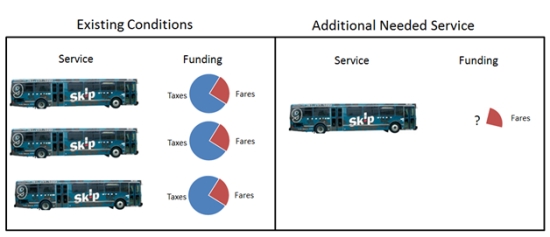
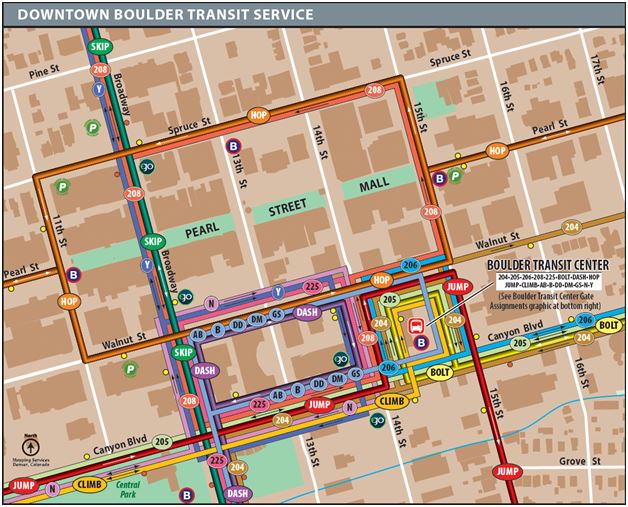
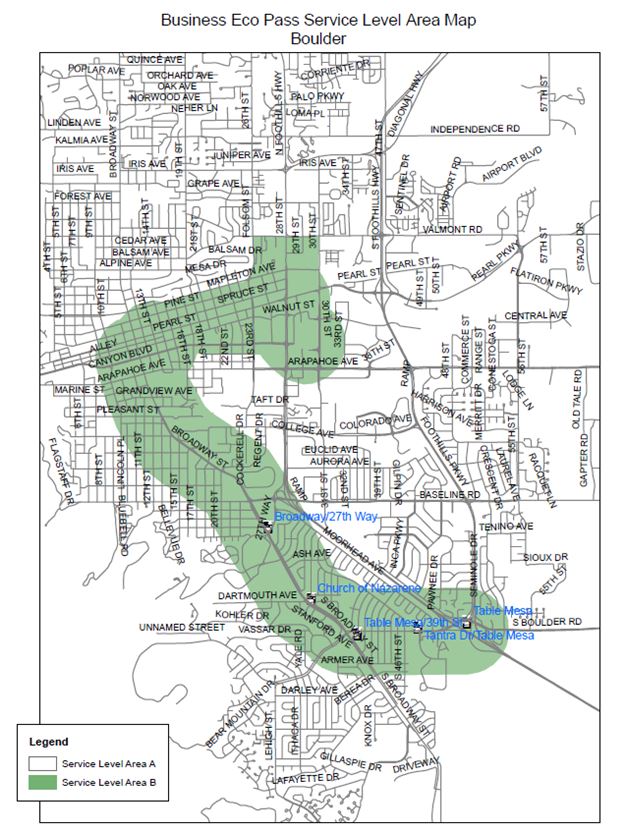
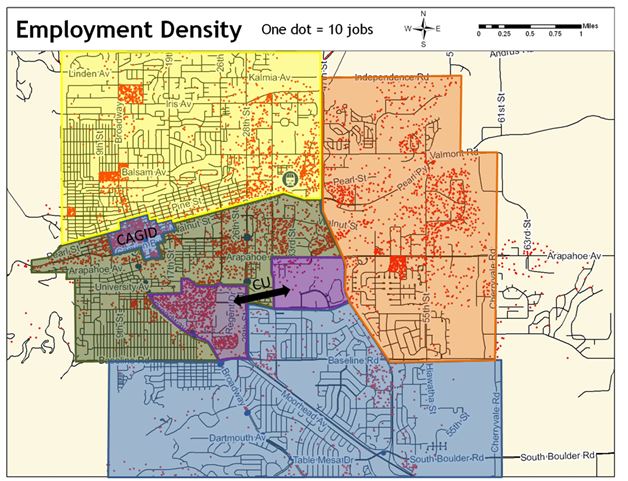



 (11 votes, average: 3.64 out of 5)
(11 votes, average: 3.64 out of 5)